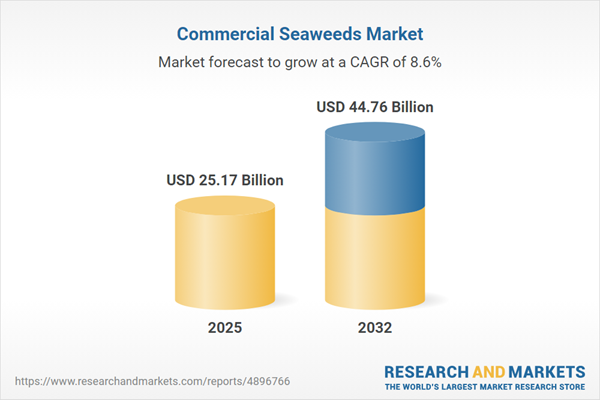Speak directly to the analyst to clarify any post sales queries you may have.
Commercial seaweeds have become an essential renewable resource, with broad relevance across industries seeking sustainable, high-value bio-based inputs. As global enterprises advance their responsible sourcing agendas, senior decision-makers are increasingly evaluating the diverse potential of commercial seaweeds to deliver operational resilience, product innovation, and long-term market differentiation.
Market Snapshot: Commercial Seaweeds Market Growth Outlook
The Commercial Seaweeds Market grew from USD 23.19 billion in 2024 to USD 25.17 billion in 2025. It is expected to continue growing at a CAGR of 8.56%, reaching USD 44.76 billion by 2032. Market momentum is driven by the integration of seaweed bioresources into food, pharma, cosmetics, agriculture, and energy supply chains. Increased adoption is underpinned by investment in advanced cultivation and processing systems designed to deliver sustainable biomass solutions tailored to evolving market demands.
Scope & Segmentation: Strategic Overview
This report covers comprehensive segmentation and regional breakdowns, providing actionable intelligence for informed decision-making:
- Type: Brown (Kelp, Sargassum), Green (Caulerpa, Ulva), Red (Gracilaria, Porphyra)
- Form: Dried, Fresh, Powder, Extracts (Agar, Alginate, Carrageenan)
- Application: Animal Feed, Biofuel, Cosmetics, Fertilizer, Food, Pharmaceutical
- Region: Americas (United States, Canada, Mexico, Brazil, Argentina, Chile, Colombia, Peru); Europe, Middle East & Africa (United Kingdom, Germany, France, Russia, Italy, Spain, Netherlands, Sweden, Poland, Switzerland, United Arab Emirates, Saudi Arabia, Qatar, Turkey, Israel, South Africa, Nigeria, Egypt, Kenya); Asia-Pacific (China, India, Japan, Australia, South Korea, Indonesia, Thailand, Malaysia, Singapore, Taiwan)
- Companies Profiled: Acadian Seaplants Limited, ALGOLESKO, Atlantic Sea Farms, AtSeaNova, Biostadt India Limited, Brandt Consolidated, Inc., Cargill, Inc., Cascadia Seaweed Corp., CJ CheilJedang Corp., CP Kelco U.S., Inc., Dalian Kowa Foods Co., Ltd., DuPont de Nemours, Inc., Gelymar S.A., Gimme Health Foods, Inc., Groupe Roullier, Indigrow Ltd., Kelp Industries Pty. Ltd., Mara Seaweed Ltd., Pacific Harvest, Qingdao Judayang Algae Industry Group Co., Ltd., Qingdao Seawin Biotech Group Co., Ltd., Seasol International Pty. Ltd., The Cornish Seaweed Company, The Seaweed Company, W Hydrocolloids, Inc.
Key Takeaways: Commercial Seaweeds Market Strategic Insights
- Seaweed has moved from a traditional marine commodity to a core input in high-value sectors due to its multifaceted bioresource properties.
- Advanced offshore farming and biorefinery models support extraction of high-purity compounds, meeting rigorous quality requirements for industrial end users.
- Collaborations among cultivators, ingredient manufacturers, and end-users are expediting novel seaweed-based applications and improving supply chain integration.
- Brown, green, and red seaweed variants each provide unique value, from structural reinforcement and nutrient cycling to specialized extractions for gelling, thickening, and bioactive compositions.
- Diversified regional production—spanning North America, Latin America, EMEA, and Asia-Pacific—enables flexibility in sourcing, tailored regulatory compliance, and scale advantages.
- Industry players are investing in traceability and sustainability frameworks to meet rising consumer and regulatory expectations for transparency and responsible production.
Tariff Impact: Navigating U.S. Policy Shifts
Newly imposed U.S. tariffs on seaweed imports are prompting processors to reassess sourcing and develop domestic or alternative supply channels. These changes create both disruption and opportunity, as increased investment in local aquaculture drives innovation and spurs partnerships between U.S. producers and technology providers. The industry is adapting by implementing agile sourcing models and enhancing logistics efficiency, leveraging cold-chain systems and modular processing units to maintain product quality and delivery reliability.
Methodology & Data Sources
Research combines comprehensive secondary data—industry publications, scientific studies, and proprietary documents—with stakeholder interviews, including growers, processors, and policy experts. Triangulation and expert review ensure findings are balanced and robust, supporting reliable recommendations for senior executives.
Why This Report Matters for Strategic Business Leaders
- Enables evidence-backed decisions on sustainable sourcing, technology investments, and new product development across core applications.
- Uncovers opportunities for regional diversification, partnership alignment, and proactive responses to shifting regulatory environments.
- Supports competitive positioning with insights on innovation pathways, operational best practices, and evolving market demand for seaweed-derived ingredients.
Conclusion
The commercial seaweeds market is positioned as a pivotal enabler of renewable and sustainable value chains across global industries. To achieve long-term resilience and growth, organizations must align strategic investments and cross-sector partnerships with ongoing technology, market, and regulatory changes.
Additional Product Information:
- Purchase of this report includes 1 year online access with quarterly updates.
- This report can be updated on request. Please contact our Customer Experience team using the Ask a Question widget on our website.
Table of Contents
3. Executive Summary
4. Market Overview
7. Cumulative Impact of Artificial Intelligence 2025
Companies Mentioned
The companies profiled in this Commercial Seaweeds market report include:- Acadian Seaplants Limited
- ALGOLESKO
- Atlantic Sea Farms
- AtSeaNova
- Biostadt India Limited
- Brandt Consolidated, Inc.
- Cargill, Inc.
- Cascadia Seaweed Corp.
- CJ CheilJedang Corp.
- CP Kelco U.S., Inc.
- Dalian Kowa Foods Co., Ltd.
- DuPont de Nemours, Inc.
- Gelymar S.A.
- Gimme Health Foods, Inc.
- Groupe Roullier
- Indigrow Ltd.
- Kelp Industries Pty. Ltd.
- Mara Seaweed Ltd.
- Pacific Harvest
- Qingdao Judayang Algae Industry Group Co., Ltd.
- Qingdao Seawin Biotech Group Co., Ltd.
- Seasol International Pty. Ltd.
- The Cornish Seaweed Company
- The Seaweed Company
- W Hydrocolloids, Inc.
Table Information
| Report Attribute | Details |
|---|---|
| No. of Pages | 181 |
| Published | November 2025 |
| Forecast Period | 2025 - 2032 |
| Estimated Market Value ( USD | $ 25.17 Billion |
| Forecasted Market Value ( USD | $ 44.76 Billion |
| Compound Annual Growth Rate | 8.5% |
| Regions Covered | Global |
| No. of Companies Mentioned | 26 |









